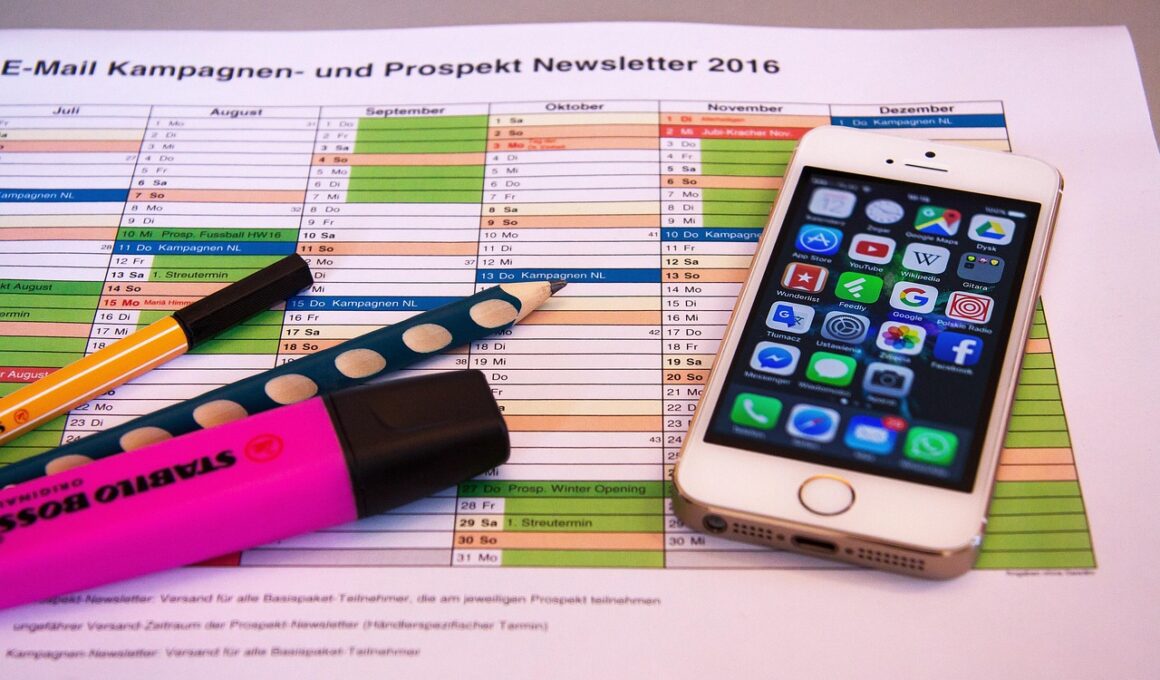Cross-Channel Scheduling: Enhancing User Experience Through Timely Posts
In today’s world, businesses must navigate the complex landscape of cross-channel scheduling effectively. Customers interact across various platforms, such as social media, email, and traditional websites. Crafting content that resonates with diverse audience segments is critical. A streamlined approach ensures the right message reaches your audience precisely when it matters the most. By analyzing consumer behavior and engagement patterns, businesses can tailor their communication strategy to boost relevance and impact. Effective cross-channel scheduling bridges the gap, creating a cohesive brand experience across every medium. Utilizing a mix of content types enables an organization to cater to different user preferences. Video, images, and text can each play a role according to channels selected for distribution. With solid planning, brands can maintain an active presence in the minds of their audience. Advanced scheduling tools provide invaluable assistance in automating posts, thereby saving time and resources. Regularly reviewing engagement metrics helps refine future campaigns, ensuring that the strategy evolves alongside audience needs and preferences. In conclusion, mastering cross-channel scheduling is essential to enhancing user experience in the increasingly digital marketplace. Businesses must remain vigilant and adaptable.
The Importance of Timeliness in User Engagement
Timeliness is a crucial component of effective user engagement within cross-channel scheduling. The longer a user has to wait for relevant content, the more likely they are to disengage. Posting content at the right moment can significantly impact how users perceive a brand’s responsiveness and relevance. Therefore, understanding when your audience is most active on various channels must inform your scheduling decisions. Leveraging analytics tools can help identify peak engagement times, making it easier to plan posts accordingly. Brands that consistently interact with audiences at optimal times tend to see heightened engagement levels and improved customer satisfaction. Incorporating thematic or seasonal trends into your scheduling can also enhance relevance and create urgency, prompting users to act. For example, posting before major holidays or events can spark interest and drive customers to engage. Additionally, time-sensitive promotions, early access offers, and limited-time deals can create a sense of excitement and exclusivity among users. Overall, maintaining a schedule centered around timely content delivery can positively influence user experience and brand perception. The power of timely outreach transforms sporadic engagement into sustained and meaningful connections with audiences.
Another important aspect of cross-channel scheduling is understanding the channel dynamics. Each platform serves different purposes and caters to diverse audience preferences. For instance, users consume information on social media platforms like Instagram and Facebook differently compared to LinkedIn or email. Familiarizing yourself with these distinctions is essential when developing a content strategy. Content must be tailored to fit the unique style and audience of each platform for maximum engagement. This means varying the tone, format, and visuals used in posts to optimize their effectiveness. Furthermore, content amplification is crucial; creative repurposing can extend the lifespan of quality content across channels, optimizing reach and engagement. For example, a successful blog post can be distilled into bite-sized social media posts, shared on various platforms while directing traffic back to the original article. Monitoring cross-channel performance enables brands to fine-tune their scheduling strategy and approach. This means continuously assessing engagement levels, reaction metrics, and consumer interactions. Ensuring consistency while adapting content for individual platforms creates a seamless user experience without losing brand identity. Thus, organizations can leverage multi-channel touchpoints to maximize user engagement and satisfaction.
Another critical consideration in cross-channel scheduling is audience segmentation. Not all users respond similarly to the same content; different demographics exhibit unique preferences. Therefore, segmentation allows for targeted content delivery that resonates with specific audience segments. Creating tailored messages based on user behavior, interests, and demographics tends to yield higher engagement rates. Implementing personalization techniques enhances user experience significantly. A well-executed segmentation strategy can improve not only content relevance but also overall user engagement. Organizations can utilize customer data and analytics tools to identify segments efficiently, aiding their scheduling decisions. Furthermore, running various campaigns for each demographic can uncover insights into what content resonates best within each group. Testing and optimizing content for different segments encourages continuous learning. This approach sheds light on user preferences over time, enabling brands to refine their strategies based on real data. It’s essential to embrace data-driven decision-making within cross-channel scheduling. This allows organizations to respond and adapt quickly to changing audience dynamics. Focusing on audience segmentation enhances how users experience interactions with your content across different platforms.
Utilizing Automation for Efficient Scheduling
Automation tools have revolutionized the way businesses manage their cross-channel scheduling efforts. By utilizing automated tools, organizations can save substantial time and effort. These platforms aid in scheduling content across different channels simultaneously, ensuring timely delivery. This capability is especially beneficial for brands juggling multiple platforms and tight deadlines. Automation also ensures consistent posting frequency, helping maintain brand visibility amidst fast-paced digital landscapes. Furthermore, pre-scheduling allows marketing teams to plan campaigns strategically, crafting messages that align with upcoming events or trends. Automation tools can analyze engagement metrics to suggest optimal posting times based on historical performance data. This valuable feature helps businesses refine their strategy further, maximizing user engagement. Additionally, automated tools often provide performance reports and insights, improving future scheduling efforts. Regular evaluations allow brands to adjust tactics, ensuring they remain proactive in their outreach. Moreover, some platforms include advanced targeting features, enabling organizations to reach specific audience segments effectively. By harnessing automation, brands can elevate their cross-channel scheduling game, optimizing user experience by delivering precise content consistently. This allows for better resource allocation while maintaining a strong brand presence across digital channels.
Furthermore, cross-channel scheduling unlocks rich storytelling opportunities. By integrating various media formats across channels, businesses can create a compelling narrative that captivates audiences. For instance, launching a new product can be communicated through a series of posts that utilize video teasers, blog articles, and social media stories. Both storytelling and user engagement strengthen brand loyalty and influence. Successfully combining these mediums can enhance the emotional impact of marketing messages and deepen user connections. The synergy between these channels means that a coherent narrative delivered through storytelling elevates the overall user experience. To achieve this, brands need to develop a comprehensive narrative strategy that incorporates each platform’s strengths. Visual content can capture attention on social media, while in-depth articles can provide further context. Targeting the same audience segment across multiple touchpoints amplifies their experience, allowing brands to seamlessly guide users from one piece of content to another. Adding interactive elements like polls, quizzes, and user-generated content can further enrich the experience. Thus, integrating storytelling techniques into cross-channel scheduling not only engages users but persuades them to remain connected with your brand.
In conclusion, mastering cross-channel scheduling is a pivotal aspect of enhancing user experience through timely posts. A well-structured strategy involves understanding user behavior, segmenting audiences effectively, and leveraging automation tools. Timeliness directly impacts user engagement and satisfaction, making it paramount to stay attuned to audience preferences and optimal posting times. Additionally, adapting content for various channels ensures that branding remains consistent while still catering to diverse user needs. Storytelling, when executed through cross-channel strategies, creates a richer, more impactful narrative that fosters lasting connections. Brands that actively participate in their customers’ journeys by delivering timely, relevant, and engaging content can establish strong relationships and drive loyalty. Regularly evaluating performance metrics will guide future efforts, helping organizations refine their strategies for continued success in delivering meaningful user experiences. Businesses must continually adapt to the evolving digital landscape and the changing preferences of their audiences. In a world where competition is fierce, those who master cross-channel scheduling will emerge as leaders in user engagement. Embracing these practices allows brands not only to survive but to thrive in the dynamic digital marketplace.
Examining the implications of cross-channel scheduling reveals its role in crafting a responsive, engaging, and personalized user experience that resonates across platforms. The comprehensive integration of cross-channel marketing fosters a seamless transition for users, allowing audiences to discover a brand’s message while interacting through their device of choice. Utilization of consistent branding strategies resonates with users and nurtures their trust. Brands demonstrating a commitment to understanding their customer preferences are often viewed more favorably. Moreover, automating scheduling aids in efficiently building campaigns that cover multiple platforms simultaneously. Strategic timing aligned with user engagement leads to an enhanced user experience. Furthermore, exploration into audience segmentation allows brands to tailor marketing approaches specifically. Implementing these key facets of cross-channel scheduling enhances the effectiveness of reaching broader audiences. Analysis of engagement metrics will assist in optimizing performance. The iterative nature of content strategy bolstered by insightful data allows organizations to revise their plans. Overall, investing in cross-channel scheduling practices serves as a catalyst for providing an agile and impactful user experience, enabling a brand to maintain relevance and connection in the ever-evolving digital landscape.


